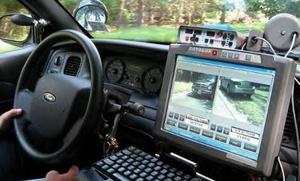Border securityUnisys to expand WHTI license plate-scanning project at border
Unisys wins 5-year award improves on Western Hemisphere Travel Initiative; WHTI uses automated license plate reader technology to screen vehicles crossing the border, and radio frequency identification technology to confirm the citizenship and identity of travelers carrying WHTI-approved, RFID-enabled travel documents

Operational ALPR in police vehicle // Source: vosizneias.com
Unisys Corp. will build an advanced identification system for people and vehicles entering and exiting the United States across the borders with Mexico and Canada.
The 5-year Land Border Integration contract from U.S. Customs and Border Protection, a unit within the Homeland Security Department, has a ceiling value of $350 million over five years and allows for additional scope to be added at the government’s discretion, according to a Unisys statement. The new contract follows Unisys’ work on the Western Hemisphere Travel Initiative contract, awarded in 2008, the company said.
David Hubler writes that WHTI, which was implemented 1 June 2009 at all land and sea ports of entry, uses automated license plate reader technology to screen vehicles crossing the border, and radio frequency identification technology to confirm the citizenship and identity of travelers carrying WHTI-approved, RFID-enabled travel documents.
Capitalizing on the initial success of the WHTI implementation, CBP and Unisys are expanding the project using innovative technologies and processes that will provide further efficiencies at the land borders, the company said.
Hubler notes that license plate readers are the core technology component of the “triangle strategy,” which capitalizes on WHTI investments in inbound processing, outbound enforcement operations and Border Patrol checkpoints to ensure that information is available as needed at each point in the process.
The new contract has one firm fixed-price base period worth approximately $29 million and four 1-year options, each valued at approximately $25 million.
